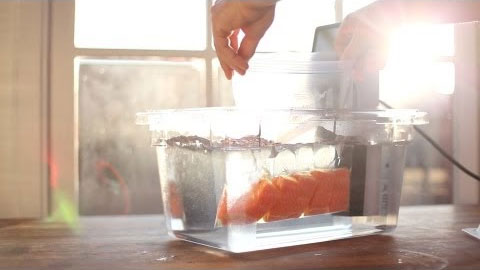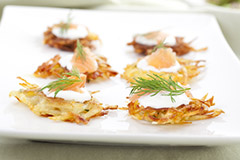A friend got me the cookbook Modernist Cuisine at Home for the holidays. At first, I was less than thrilled to receive yet another cookbook. It's huge. And insanely heavy. And I have a million cookbooks that people have given me through the years. Some I love, but I have to admit that some I've leafed through and never used. I had a separate friend over and asked him if he wanted to take "Modernist Cuisine at Home" off my hands. He informed me that I do not want to give that cookbook away as it is one of the most important cookbooks of the past several years.
So I held on to it and browsed it over the weekend. Once I decided to give it a chance, I couldn't put it down. First of all, it's beautifully put together. The photography is fantastic. It's extremely thorough - covering all of the equipment that they propose, where to find some of the more esoteric ingredients, and discussing their philosophy of cooking.
After I read most of the book, I was ready to make some big purchases in the kitchen. The first one was a sous vide. For those that have never heard the term (I had never heard of sous vide cooking), it literally means "without air". You seal food in plastic and get as close as you can to a vacuum seal. Then you cook the food in a hot water bath. Because you're cooking it in water, you can very precisely control the temperature of the food without fear of overcooking the outside. So if you want to cook a chicken to 160°, you can cook the whole thing to that temperature exactly and still have a just barely cooked outside. Steaks are perfectly cooked all the way through – not overcooked on the edges. No water or oil is introduced to the food. And the food doesn't dry out because there's no place for the moisture to go. Usually, you will finish meat off by searing, frying, broiling, or blowtorching the outside to give it a nice caramelized outside.
Technically, you don't have to buy any fancy equipment to cook sous vide. You can put meat into Ziploc freezer bags and get most of the air out by submerging the bags into water (not all the way, though) to force the air out. And to control the water bath, you need any old thermometer. I think Modernist Cuisine at Home recommends boiling water first, then taking its temperature as it cools, then putting in the ingredients as the water approaches the right temperature. (Fish is a good candidate for this because it doesn't need much time in the bath, so you can be a bit more liberal about the temperature of the water. I don't think this would hold up to something that needs more time in a precise water bath.)
However, I decided that I wanted to make sous vide cooking a regular thing, so I got a dedicated sous vide appliance. It happened to arrive on David's birthday, and I had some salmon for dinner, so I decided to make dinner sous vide.
I put the salmon fillets in freezer Ziploc bags with a 1/2 tablespoon of butter and used the water-displacement method to get most of the air out. I set the sous vide for 115° and put the salmon in for 28 minutes. It came out feeling not quite done. I think that's mainly a mental thing at seeing food that is cooked but not caramelized.
I put a little BBQ sauce over the tops and put it in the broiler for about 5 minutes, just to give it a little outside color. Then I salted the top.
That was it. I would love to say that it was some insanely complicated recipe, but it couldn't have been easier.
The salmon came out flaky and perfect. There were no overdone or underdone spots. David said that it was the best salmon I've ever prepared. It was certainly the moistest.
I'm a sous vide convert now.
I'm especially looking forward to grilling season now so that I can sous vide food and then finish it off with high grilling heat. All the sous vide cookbooks say that hamburgers were made for sous vide.

